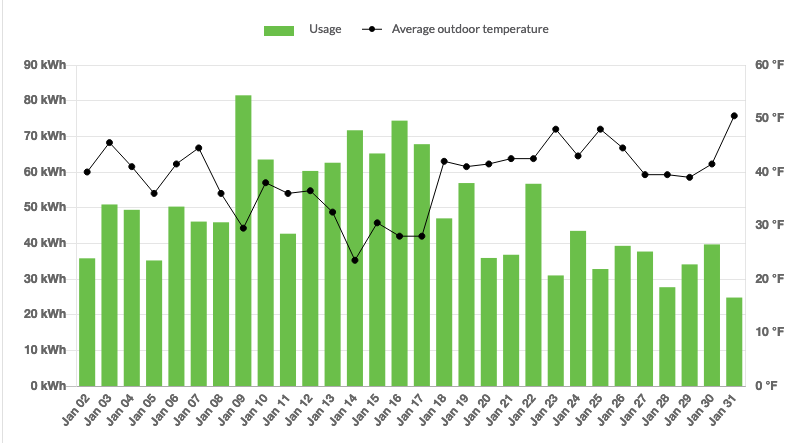Heating and Cooling (homes):
Reading to date:
At this point you have hopefully read the chapter on Heating and Cooling from David's book before we start this discussion. This is a busy chapter that explores the basics of heating and cooling in our homes and lives.
Underlying Concept: Energy Quality
Our homes and workplaces are a significant location for energy use but they are also where the forms of energy we need vary the most. This makes it a great time to talk about the concept of energy quality. How many different forms of energy do you use in your house? How many of them can be turned into some other form of energy? In most cases converting from one form of energy to another is a one way process. We can use fuel oil to make heat in a furnace but it is difficult (see below) to make fuel oil from heat. Think also about what we need to do with our energy. Some forms of energy can run motors, but not our computers. Some can heat our houses but not run motors. These are all quality considerations.
Sidenote:
I just saw this report about some folks who have figured out how to use concentrated sunlight (lots of heat) to make jet fuel from C02 in the atmosphere. Crikey! Its an interesting example of the process of taking a lower quality energy source and upgrading it to a higher quality source. There are substantial energy costs as well a technology needed to make this happen.
One way of thinking about this is that higher quality energy sources can be made into lower quality energy but not so much the other way around without significant energy cost.
Energy Quality: Higher quality energy sources can be converted to more other forms of energy.
Underlying Concept: Energy Portability
Another useful concept about energy that is evident in our houses is the portability of that energy. Some forms of energy have to be used where they are generated and others can be more or less easily transported to other locations. Of course, there are differences since fossil fuels are dense and take different methods to transport them and electricity flows on wires (mostly). Portability also depends on the underlying infrastructure. Moving gasoline takes a transportation infrastructure, moving electricity requires the grid, sunlight can't be moved at all, and natural gas takes pipelines.
Energy Portability: More portable energy sources can be delivered across greater distances with lower added cost after the infrastructure is in place.
Underlying Concept: Energy Storage
One of the features of our power grid that I hope you noticed is that the energy is generated exactly as it is needed. This is a system of energy generation that is a result of our ability to use fossil fuels as stored energy to be released when needed. Sunlight is at the opposite extreme. The sunlight is there or it is not there but we can't store the sunlight. True, we can convert the sunlight (energy quality) to other forms of energy and they may be storable but sunlight itself is not storable.
Energy Storage: Energy sources can be stored with less loss and for longer periods of time will be higher on this scale.
Activity: Consider these forms of energy: Heat, Sunlight, Wind, Fossil Fuels (natural gas, oil), Hydropower, and Electricity. Using our definitions of energy quality, portability, and storage:
Rank these 6 forms of energy from highest to lowest quality.
Rank these forms of energy from highest to lowest in terms of their portability.
Rank these forms of energy from highest to lowest in terms of their ability to be stored.
This table will be filled in based on the discussion activity above.
| form of energy | quality | portability | storage |
| Heat | |||
| Sunlight | |||
| Wind | |||
| Fossil Fuels | |||
| Hydro | |||
| Electricity | |||
Energy Cost:
It seems useful to be conscious of the relative cost of different forms of energy. Our unit for comparison is a kWh. Here in the NW as we have discussed our electrical power costs us about $0.10/kWh.
Given that gasoline and diesel have about 35 - 37 kWh of energy in each gallon that means when the cost of gas is $3.60/gal it is exactly the same value as our electric power. I agree that the fact that 3/4 of this energy is lost in a traditional vehicle is a complicating factor.
Amusingly I once calcuated the energy in a ton of hay and compared it to our electric costs. At $200/ton for hay it's energy is worth about $0.10/kWh.
Wind farms and solar power companies can calculate the life time costs of their power plants and estimate the avearage cost/kWh. These days the cost of a kWh of energy from a wind farm or a natural gas power plant are about the same and the wind farm cost is still dropping.
There are some sources of energy that we often use that can be a little shocking when we consider their cost through this lens. In the world of electrical devices the power use is determined from the expression P = I.V. P is power in Watts, I is the current in Amps and V is the Voltage 'pushing' the current. The energy in a battery is given by Energy = P.t = I.V.t. The energy stored in a battery is usually given in terms of Ah which is the current and time parts of the expression. Here is a plot of what we can expect from a AA battery which we use for our calculators and other small electronics.
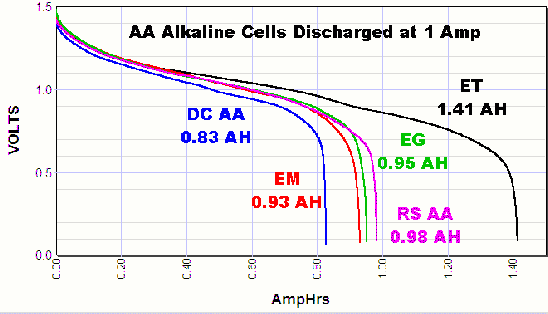
If we calculate the energy in the battery we get Energy = 1 Ah.1.5 V = 1.5 Wh. NOT 1.5 kWh but just 1.5 Wh! The best price I can find for an AA battery in bulk is around $.25 (though smaller packs at checkout stands are about $2.00 each). We would have to buy 666 AA batteries (1000Wh/(1.5 Wh/battery)) to get 1 kWh of energy. The equivalent cost is $167/kWh. Yikes -- makes you never want to buy a battery again. Rechargeable batteries are a different story of course.
For contrast consider the heat energy in sunshine. If we let sunshine into our house it brings heat in. From an oversimplified perspective that energy is 'free' except for the cost of planning ahead to put the window in where it does the most good. (yes, I know, the window also costs us energy as the heat runs out)
My point here is to get us all thinking about energy in a richer and more nuanced way.
Activity: Think about the energy you use in your home. After heat and hot water what do you think your largest individual energy uses are? What could you do to find out if you're correct?
David's Assessment for (his) Home:
Part of what David does very nicely in his book is lump things together so we don't lose track of the big picture. As we will see shortly making hot water for a whole range of purposes is a major use of energy in our homes.
Bath/Shower: 5 - 8 kWh/p/d
David starts with a discussion of the most obvious form of hot water which is bath water. The physics of heating water is well understood and he lays out the calculation if you are interested. I would point out that his bath is not large by American standards and 40 C is not a really hot bath. When he gets 5 kWh for a bath that could easily be 6 or 7 in a bigger hotter bath. $0.50 for a nice bath seems pretty reasonable to me but if I do that every day that's $15 or so a month just for my baths.
The same calculation for a 30 lt shower illustrates that showers CAN use a lot less energy (1.4 kWh). We should probably take a closer look at this to improve our understanding. 30 lt is basically 8 gallons. The next consideration is what is the flow rate of your shower head? You are all aware of low flow and high flow shower heads. Sometimes when I go to conferences I am amazed at the flow rate in hotel showers. Conversely I have put low flow shower heads in my house and they have been rejected by members of the household as inadequate. You might find it interesting to see if you can determine the flow rate of your shower head. The newest standard for California and other western states is about 2 gal/min. That suggests that most of us have shower heads that deliver about 2.5 gal/min which is standard. Notice that this means David is talking about a shower that is about 3 min long. I don't know about you but that's quick. The average shower for most folks is 10 min (who got that data?) which means we're using more like 20 or 25 gal of hot water. Even a shower head that meets the newest standard of 1.8 gal/min uses 18 gal for an average shower. Never mind those longer showers that 'sometimes' happen. That means a shower use as much energy as David's bath or even a little more. Just something to think about.....
Cooking and Cleaning: 6 - 8 kWH/p/d
It's an important insight that most of what happens when we cook things is that we heat up the water in the food which changes the characteristics of the constituents of the food. When we wash clothes or dishes most of the energy goes into heating up the water in one form or another. David does a nice job of exploring the different applicances in his house and how long they are used in a typical day. I suspect there might be a lot of variation in different homes but it gives us a sense for how that investigation might work. Since David's kids are grown and out of the house his numbers reflect 2 people in the household. Consider the amount of time various appliances are used in this table and compare it to your own household.
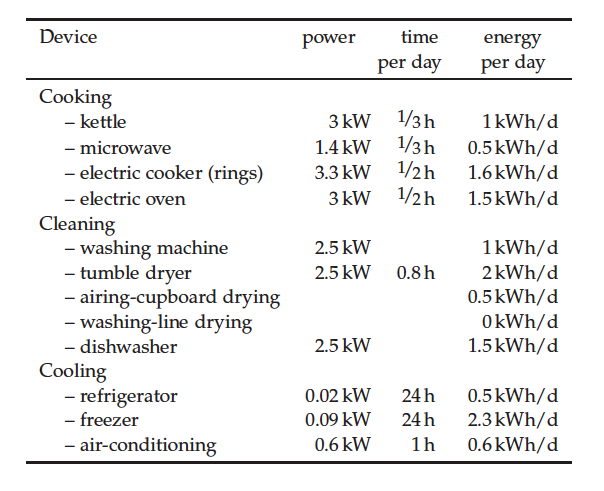
HW: Heat
A typical electric dryer has a power rating of 5 kW. If it takes 40 min to dry a load of clothes how much energy is used? How does this compare to David's number in the table? Do you think you dry a load of clothes every day on average? How much would it save you (at $0.10/kWh) to hang your clothes out to dry on a clothesline for a month?
Heating (Cooling): 24 kWh/p/d
Central heating is not as universal in other parts of the world as it is in this country. David takes a lovely approach by imagining we each carry around a little space heater to keep ourselves warm as we go from room to room. This is actually an approach that people use in other parts of the world. When I was a kid in New Zealand my bedroom was icy in the winter time and I really needed that hot water bottle!
A key message that is probably pretty clear for everyone who lives in Central Oregon is that staying warm (heating your house) is a major energy expense for much of the year. Remember that because we are trying to figure out average use we're talking about considering both summer and winter in our overall thinking. Most of use see our energy bill double or triple for 6 months out of the year which suggests that heating costs are at least half of our energy needs when considered throughout the year. This aligns pretty well with David's estimation.
It is worth noting that in large parts of the United States energy needs for cooling are pretty much the same as our heating needs here in the NW. Remarkably it seems to balance out.
Cross Checking David's Result:
The discussion of energy use in our homes gets a little complicated because there are a variety of ways that we heat our homes. Mostly, in Central Oregon, we use electricity to cook our food and heat our water. In many cases we also use electric heating units in our homes. The expense of this leads many to supplement their heat with wood which takes comparable amounts of energy. Some folks have access to natural gas which is slightly less expensive but ultimately it takes the same amount of energy to heat the home.
There a number of sources that put the average electrical use in Oregon at right around 1,000 kWh/month. (1 MW/month). If we divide that by 30 days we get 33 kWh/d/household. This is in the same ball park as David's numbers although it needs to be divided by 2 to get 17 kWh/p/d. Given that some households use other forms of heat and that represents at least half of the energy use it feels like David's estimate of our household use is pretty much in line with our use.
On the other hand, if we look at the Sankey plot of our energy use it only shows 11.9 Quads out of 100 Quads being using in residential settings which is roughly 12%. Our total energy use is 250 kWh/p/d in the US so that suggests that our individual use is more like 30 kWh/p/d. This is not way off from our earlier discussion but it is a little bothersome. I think that this is partly due to the wide range of climates across the US and differences between urban, suburban, and rural energy use patterns. Someday I will have to take a deeper dive into the data and try to sort it out but for now I'm going to accept that for here in Central Oregon Davids estimate of 40 kWh/p/d seems pretty reasonable.
Community Use of Energy:
An interesting thing to think about is how much of the day you spend in buildings where heat and light is provided for you. Before COVID most of us would be spending roughy half our days in school buildings and job sites where someone else is paying to keep the space heated and illuminated. It is an interesting question what our personal share of that energy is.
A small example of this are the lights in a classroom. A typical medium classroom has about 2000 W of light bulbs not counting that really bright bulb in the projector. If there are 10 students in the classroom for 2 hrs that is 4 kWh/10 students = 0.4 kWh/p/class. If you are on campus for 6 hours a day then the college is providing about 2.5 kWh/d in lighting alone for you. This sort of thing is one of the hidden energy costs in our community.
Take Home Message:
We use, individually, roughly the same amount of energy in our homes that we use to drive our cars around: 40 kWh/p/d.
HW: Heat
What can you learn about your energy use by comparing your power bill for January with the power bill for June? What is different for those who use gas to heat their homes and those who use electric heat in one form or another? Here is a January and June power bill. What do these bills tell us (in kWh) about the energy used for heating during the winter?
Energy Use in our Homes:
Lets zoom in a little on the way we use energy in this country. There are three plots below that span from 1978 to 2015. The first thing I would want you to notice is that the total amount of energy we use in our homes seems to have stayed remarkably constant these 40 years at around 11 Quads. What has changed significantly is the allocation of that energy to particular tasks. In general we need to consider heating and AC to be part of the same need to manage the environment in our homes. In the 70's this represented nearly 3/4 of our energy use. By the early 2000's it's around half and it is still around half in 2015. This represents an important change in the quality of our homes and their energy efficiency. The energy we use to keep our homes warm or cool is 2/3 what is was 40 years ago and our homes are, on average, substantially bigger.
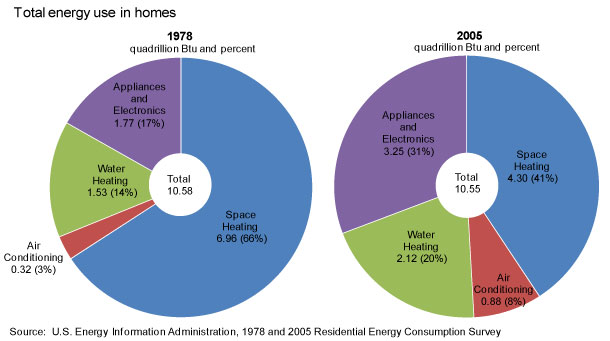
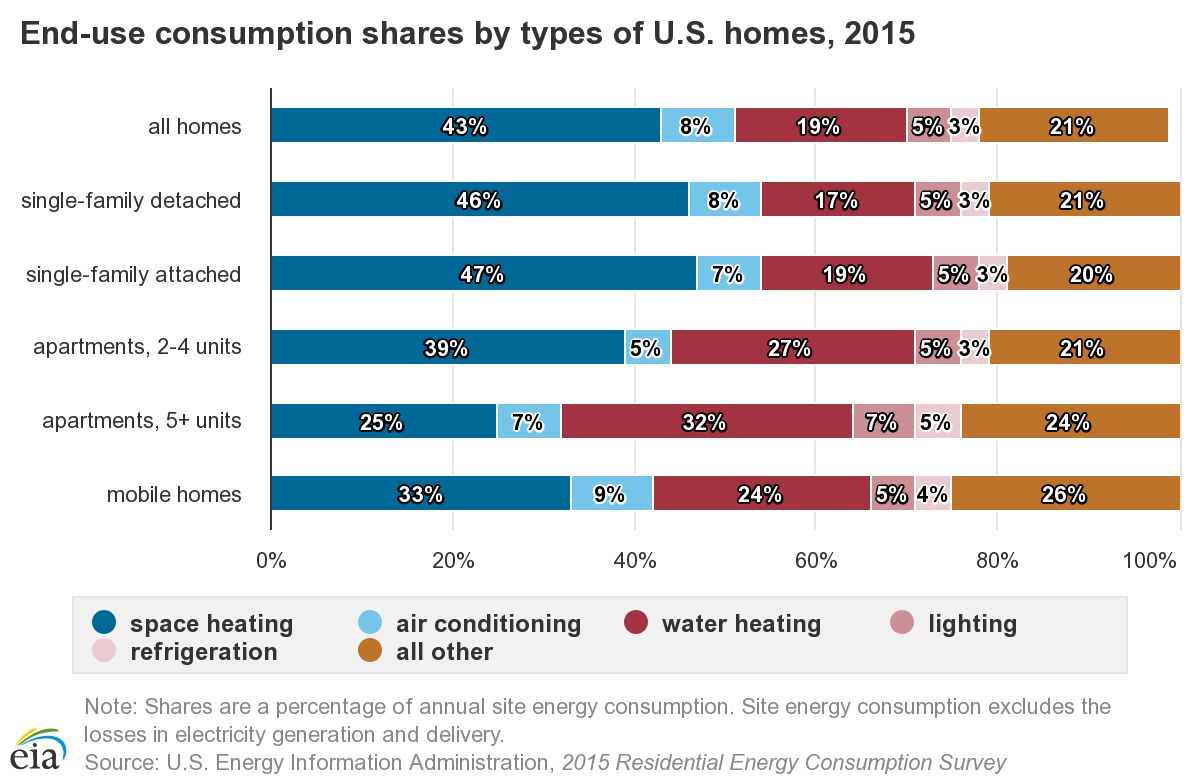
One could also note that the energy we use to heat water has remained a pretty consistent portion of the overall energy use as has the energy we use for other appliances and electronics. In looking for data about our energy use it was easy to get apparently conflicting data which sometimes just describes electrical energy use.
Messaging:
David's point throughout his book is that you have to understand the numbers to make effective decisions. Part of what this means is that if we are going to make changes that make a difference we need to address the largest uses of energy not the smallest. We do have lots of tech in our homes and it does use energy BUT, as an example, we could probably turn off all of our tech every day and make less of a difference than if we took a shower every other day instead of every day. It definitely makes a bigger turn down the temperature of your house by several degrees in the winter than to shut off your computer.
HW: Heat
A typical computer uses about 100 W of power even when it's sleeping. If we were to actually turn it off for 10 hrs a day how much energy would be save each day? What percent of our daily energy use of 40 kWh is this? Now consider your phone charger which uses 1 W of power when it's plugged in and not being used. How much energy does the charger use in a day if it's plugged in 24/7? What percent of our daily energy use of 40 kWh is this?
Big Take Aways:
In considering our energy use in our homes it is important to recognize that the big players are heating and cooling along with hot water. These are the patterns of energy use that make a difference if we can change them.
Assignment: HW: Heat
Complete and assemble your solutions to all the HW problems (3) listed here showing all the steps in your solutions. Scan to a pdf and turn in on LMS. Please review HW format expectations for guidance about your homework solutions.
Reading Ahead:
Next you will read the chapter on Heat: Tech from David's book before we start the next discussion. This is a chapter that lays out more details about how we be more efficient in our use of heating and cooling in our built environment.
